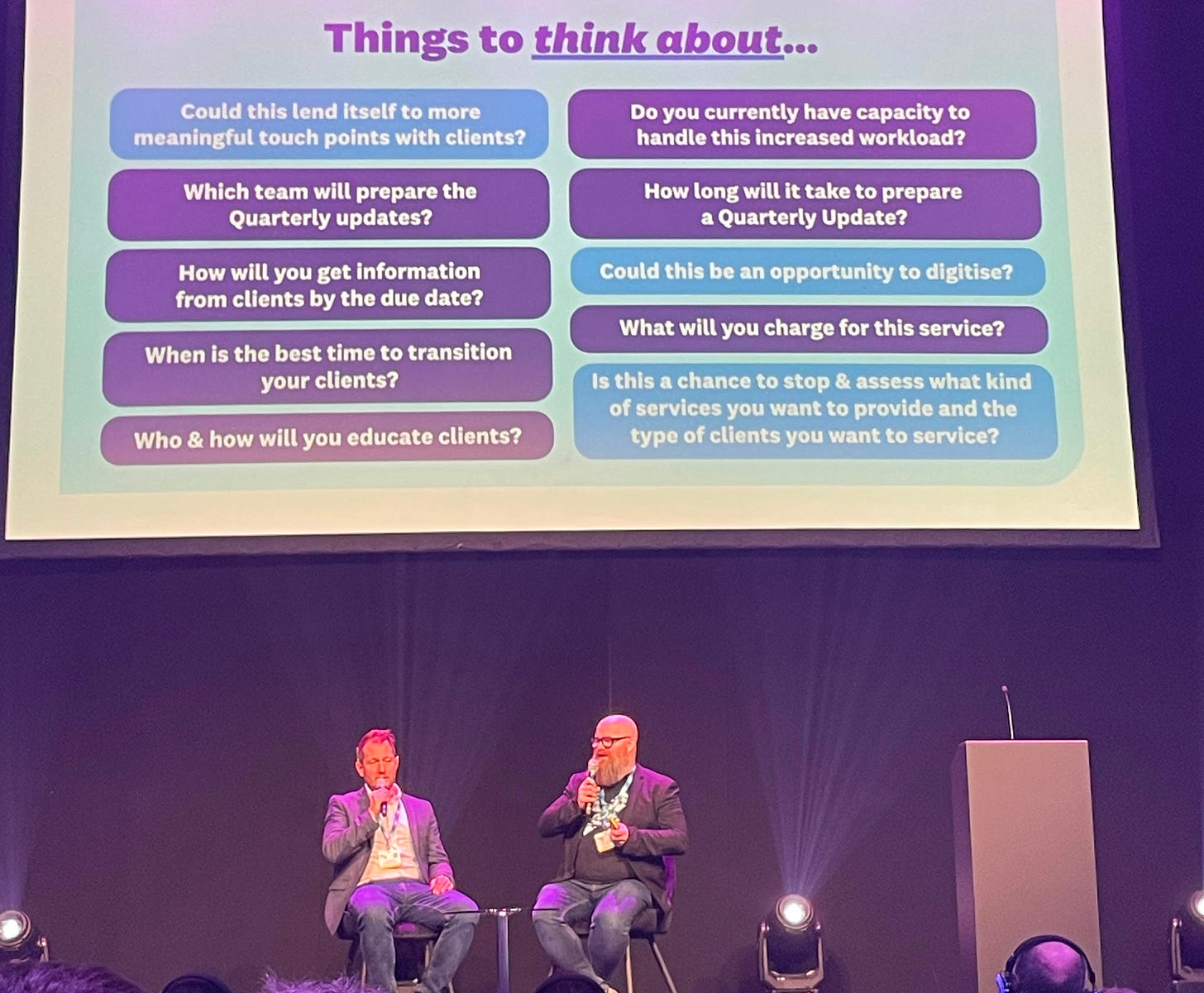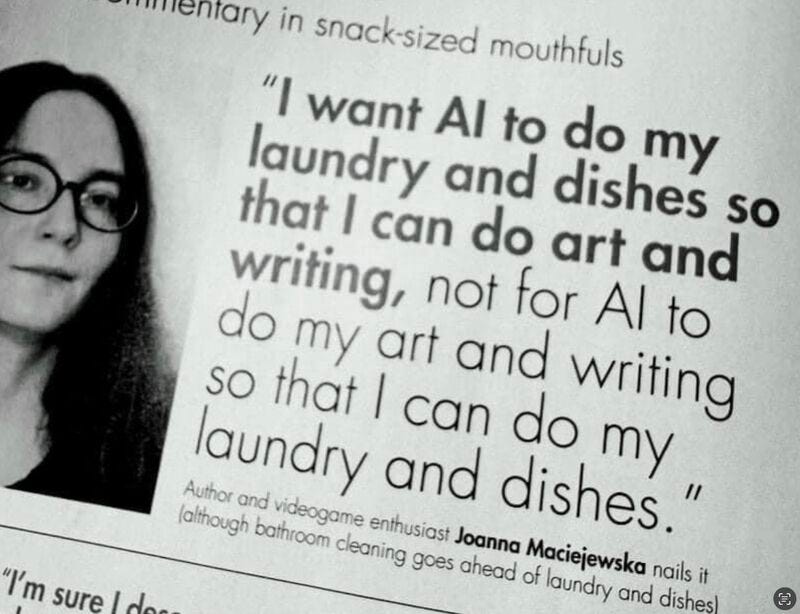👋 Hey, it’s Melody. Welcome to my weekly newsletter for leaders and A-players who want to build, scale, and manage remote teams more effectively.
Read time: 5 minutes
Last week I was at an industry event packed with digital-first teams and tech vendors showing off their latest tools.
You’d expect it to be buzzing with AI tools and automation demos. And it was.
But what surprised me was this big gap in the room.
On one side: early adopters already using ChatGPT, building prompt libraries, and testing new workflows.
On the other: leaders and managers still sitting back… curious, maybe, but cautious AF.
Or even flat-out resistant.
I heard things like:
“It’s not secure enough yet”
“I don’t want my staff getting lazy”
“We don’t really have time to figure it out”
“Our clients wouldn’t want us using that”
And it struck me: most of the resistance wasn’t really about the tech. It was about what we think AI is for.
It reminded me of a Joanna Maciejewska’s viral post on X:
“I don’t want AI to write for me and make art. I want AI to do my laundry and dishes so I can write and make art.”
We don’t need AI to replace our thinking or do things we enjoy.
We need it to give us space to think.
And for intellectual workers, it’s the mental equivalent of stopping doing dishes everyday.
Used right, AI doesn’t take your job. It clears the clutter so you can do your job — better, faster, and with more headroom.
So if you’ve been sitting in the “not ready yet” camp, here’s a simple way to think about it.
Enter: the AI sandwich
The idea comes from Ethan Mollick, a professor at The Wharton School — and it’s quickly become my favourite way to explain AI in a way that feels practical, not overwhelming.
It’s simple: AI shouldn’t replace your work — it should sit in the middle of it.
You start the process, AI helps with the heavy lifting, and then you refine the output.
Human → AI → Human.
It’s a practical way to think about how we work with AI, rather than worry about being replaced by it.
It’s built on a simple principle: humans in the loop, always.
🧠 10% human strategy
Start with intention. You define the task, provide context, set the tone.
🤖 80% AI execution
Let the AI do the heavy lifting — draft, summarise, rewrite, research.
🧑💼 10% human review
You come back in at the end, tweak, refine, double check, and make it sound like you.
That’s it.
It’s not “let AI run wild.”
It’s “delegate a chunk of the task, keep control of the outcome.”
If you’ve ever trained a junior team member, it’s not that different. You still lead. You just don’t have to do every single part yourself.
Try it on one thing this week
Don’t overhaul your firm. Don’t send the team to a 2-day AI bootcamp.
Just pick one thing and run it through the sandwich.
Here are a few good starting points:
Write the first draft of an awkward client email
Summarise a long industry update into key takeaways for your team
Turn messy meeting notes into an action plan
Rewrite a LinkedIn post in a more casual tone
Brainstorm blog ideas for your website
You frame it. AI runs with it. You review and polish.
That’s how it becomes useful.
What’s holding teams back?
From what I’ve seen, most hesitation isn’t technical — it’s cultural.
Here’s what I noticed:
Fear of errors – “What if AI gives bad info?” (You’re still reviewing it.)
Fear of lost craft – “I’m good at this, I don’t need help.” (It’s not about skill. It’s about space.)
Fear of lazy habits – “Won’t people fstop thinking for themselves?” (Only if you remove the top and bottom layers of the sandwich.)
Uncertainty over what to use it for – (Start with repeat work. Low-risk tasks.)
None of these fears are silly. They’re valid. But they’re also manageable — if you stay intentional.
Join leaders already subscribed to Remotely Led. One short, practical read each week.
Use it to clear the path, not shortcut the journey
AI shouldn’t dull your thinking. It should sharpen your focus.
You still need to bring the context, the experience, the gut feel.
AI can’t handle nuance or sense tone alone. It doesn’t know when to hold back or ask the awkward question.
So yes, use it. But stay involved.
If you skip the thinking at the start or the review at the end, your work will show it.
Done well, though? You can speed up the admin, and spend more time on the good stuff: strategy, relationships, creative thinking, leadership, growth.
A quick mindset shift to try
Instead of asking,
“Where should we use AI?”
Try this:
“What do I hate doing — and should never have been doing in the first place?”
If it’s repetitive, low-risk, and mentally draining… hand it over.
If it’s creative, client-facing, or high-trust… stay close.
That balance is where AI shines.
And where your team gets to level up, not burn out.
Get your own dose of leadership ideas, remote team tips, and AI workflows every week.
Let AI help with the dishes.
There’s no prize for holding out the longest.
And no one’s expecting you to turn your team into OpenAI overnight.
But if you want to stay sharp, keep good people, and spend your days doing more of the work you want to do, start handing off the digital dishes.
Start small.
Use the sandwich.
Reclaim your brainspace.
And if you’re already doing it, share what’s working. This is the conversation we should be having more of — not “AI vs humans”, but “How can we work better together?”
What’s one repetitive task you know your team could hand off but hasn’t yet? Or one surprising way you’ve already started using AI in your workflow? Hit reply and tell me.






ayagrii qushum